Acura MDX 2011 Repair Manual
Manufacturer: ACURA, Model Year: 2011, Model line: MDX, Model: Acura MDX 2011Pages: 609, PDF Size: 12.7 MB
Page 61 of 609
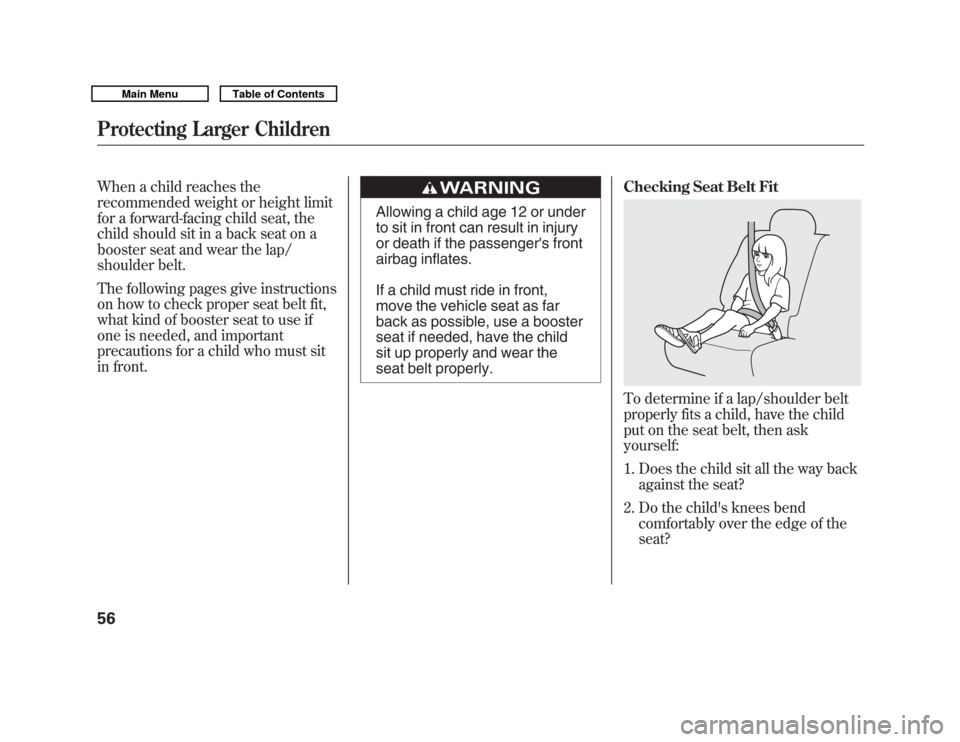
When a child reaches the
recommended weight or height limit
for a forward-facing child seat, the
child should sit in a back seat on a
booster seat and wear the lap/
shoulder belt.
The following pages give instructions
on how to check proper seat belt fit,
what kind of booster seat to use if
one is needed, and important
precautions for a child who must sit
in front.
Allowing a child age 12 or under
to sit in front can result in injury
or death if the passenger's front
airbag inflates.
If a child must ride in front,
move the vehicle seat as far
back as possible, use a booster
seat if needed, have the child
sit up properly and wear the
seat belt properly.Checking Seat Belt Fit
To determine if a lap/shoulder belt
properly fits a child, have the child
put on the seat belt, then ask
yourself:
1. Does the child sit all the way back
against the seat?
2. Do the child's knees bend comfortably over the edge of the
seat?
Protecting Larger Children5610/06/29 11:59:04 11 ACURA MDX MMC North America Owner's M 50 31STX640 enu
Page 62 of 609

3. Does the shoulder belt crossbetween the child's neck and arm?
4. Is the lap part of the belt as low as possible, touching the child's
thighs?
5. Will the child be able to stay seated like this for the whole trip?
If you answer yes to all these
questions, the child is ready to wear
the lap/shoulder belt correctly. If
you answer no to any question, the
child needs to ride on a booster seat. Using a Booster Seat
A child who has outgrown a forward-
facing child seat should ride in a
back seat and use a booster seat until
the lap/shoulder belt fits them
properly without the booster.Some states, Canadian provinces and
territories also require children to
use a booster seat until they reach a
given age or weight (e.g., 6 years or
60 lbs). Be sure to check current
laws in the states, provinces or
territories where you intend to drive.
Booster seats can be high-back or
low-back. Whichever style you select,
make sure the booster seat meets
federal safety standards (see page
47) and that you follow the booster
seat maker's instructions.
CONTINUED
Protecting Larger Children
57
Driver and Passenger Safety
10/06/29 11:59:04 11 ACURA MDX MMC North America Owner's M 50 31STX640 enu
Page 63 of 609
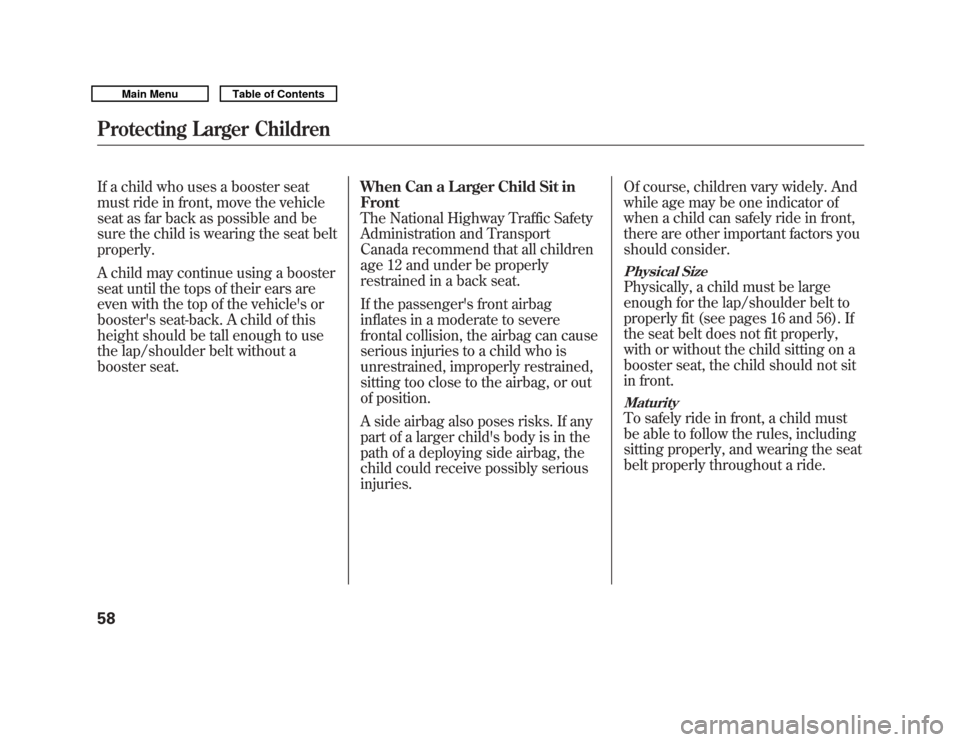
If a child who uses a booster seat
must ride in front, move the vehicle
seat as far back as possible and be
sure the child is wearing the seat belt
properly.
A child may continue using a booster
seat until the tops of their ears are
even with the top of the vehicle's or
booster's seat-back. A child of this
height should be tall enough to use
the lap/shoulder belt without a
booster seat.When Can a Larger Child Sit in
Front
The National Highway Traffic Safety
Administration and Transport
Canada recommend that all children
age 12 and under be properly
restrained in a back seat.
If the passenger's front airbag
inflates in a moderate to severe
frontal collision, the airbag can cause
serious injuries to a child who is
unrestrained, improperly restrained,
sitting too close to the airbag, or out
of position.
A side airbag also poses risks. If any
part of a larger child's body is in the
path of a deploying side airbag, the
child could receive possibly serious
injuries.Of course, children vary widely. And
while age may be one indicator of
when a child can safely ride in front,
there are other important factors you
should consider.
Physical SizePhysically, a child must be large
enough for the lap/shoulder belt to
properly fit (see pages 16 and 56). If
the seat belt does not fit properly,
with or without the child sitting on a
booster seat, the child should not sit
in front.MaturityTo safely ride in front, a child must
be able to follow the rules, including
sitting properly, and wearing the seat
belt properly throughout a ride.
Protecting Larger Children5810/06/29 11:59:04 11 ACURA MDX MMC North America Owner's M 50 31STX640 enu
Page 64 of 609

If you decide that a child can safely
ride up front, be sure to:●
Carefully read the owner's manual,
and make sure you understand all
seat belt instructions and all safety
information.
●
Move the vehicle seat to the rear-
most position.
●
Have the child sit up straight, back
against the seat, and feet on or
near the floor.
●
Check that the child's seat belt is
properly and securely positioned.
●
Supervise the child. Even mature
children sometimes need to be
reminded to fasten the seat belts
or sit properly.Additional Safety Precautions
●
Do not let a child wear a seat belt
across the neck.
This could result
in serious neck injuries during a
crash.
●
Do not let a child put the shoulder part of a seat belt behind the back
or under the arm.
This could cause
very serious injuries during a
crash. It also increases the chance
that the child will slide under the
belt in a crash and be injured.
●
Two children should never use the
same seat belt.
If they do, they
could be very seriously injured in a
crash.
●
Do not put any accessories on a
seat belt.
Devices intended to
improve a child's comfort or
reposition the shoulder part of a
seat belt can make the belt less
effective and increase the chance
of serious injury in a crash.
Protecting Larger Children
59
Driver and Passenger Safety
10/06/29 11:59:04 11 ACURA MDX MMC North America Owner's M 50 31STX640 enu
Page 65 of 609
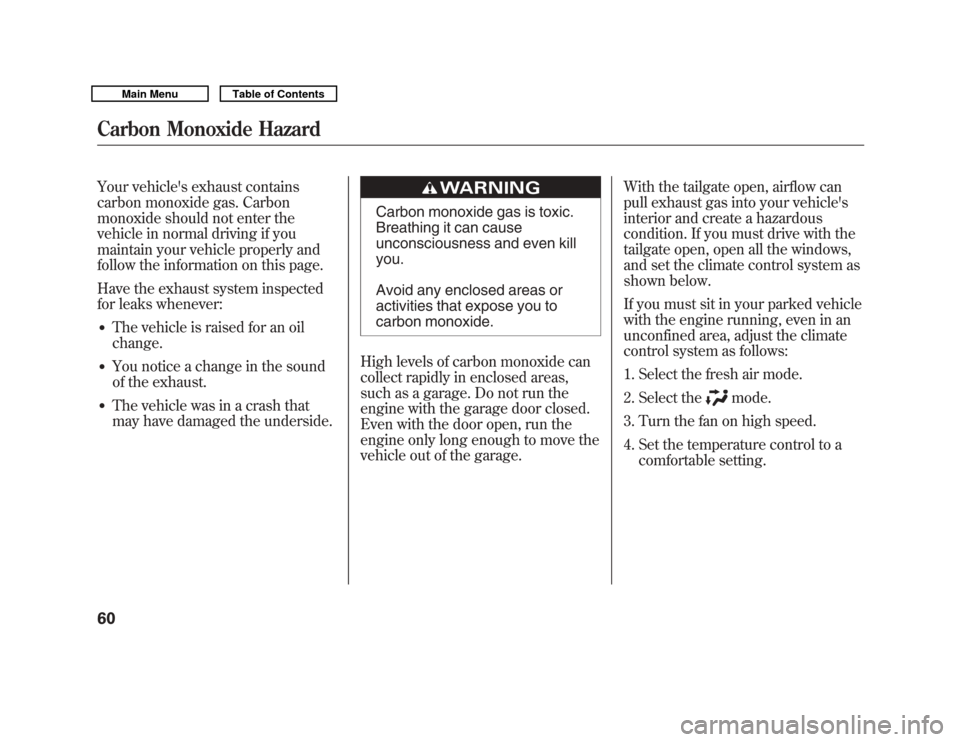
Your vehicle's exhaust contains
carbon monoxide gas. Carbon
monoxide should not enter the
vehicle in normal driving if you
maintain your vehicle properly and
follow the information on this page.
Have the exhaust system inspected
for leaks whenever:●
The vehicle is raised for an oil
change.
●
You notice a change in the sound
of the exhaust.
●
The vehicle was in a crash that
may have damaged the underside.
Carbon monoxide gas is toxic.
Breathing it can cause
unconsciousness and even kill
you.
Avoid any enclosed areas or
activities that expose you to
carbon monoxide.
High levels of carbon monoxide can
collect rapidly in enclosed areas,
such as a garage. Do not run the
engine with the garage door closed.
Even with the door open, run the
engine only long enough to move the
vehicle out of the garage. With the tailgate open, airflow can
pull exhaust gas into your vehicle's
interior and create a hazardous
condition. If you must drive with the
tailgate open, open all the windows,
and set the climate control system as
shown below.
If you must sit in your parked vehicle
with the engine running, even in an
unconfined area, adjust the climate
control system as follows:
1. Select the fresh air mode.
2. Select the
mode.
3. Turn the fan on high speed.
4. Set the temperature control to a comfortable setting.
Carbon Monoxide Hazard6010/06/29 11:59:04 11 ACURA MDX MMC North America Owner's M 50 31STX640 enu
Page 66 of 609
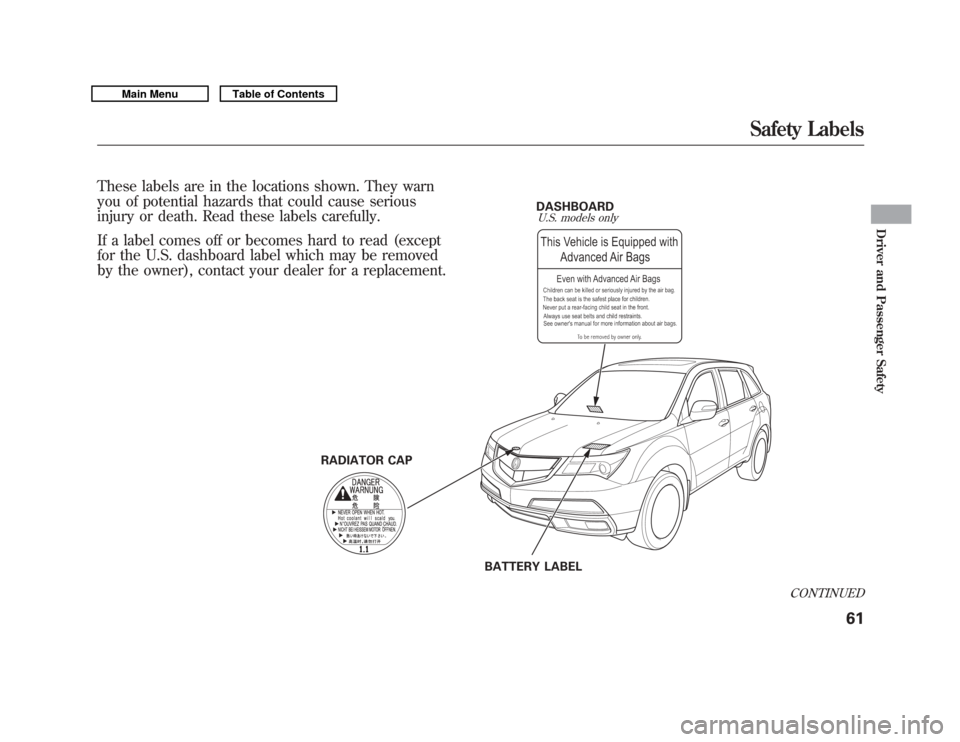
RADIATOR CAPDASHBOARD
BATTERY LABEL
U.S. models only
These labels are in the locations shown. They warn
you of potential hazards that could cause serious
injury or death. Read these labels carefully.
If a label comes off or becomes hard to read (except
for the U.S. dashboard label which may be removed
by the owner), contact your dealer for a replacement.
CONTINUED
Safety Labels
61
Driver and Passenger Safety
10/06/29 11:59:04 11 ACURA MDX MMC North America Owner's M 50 31STX640 enu
Page 67 of 609

SUN VISORU.S. modelsU.S. models
DOORJAMBSU.S. models Canadian models
Canadian models
Safety Labels6210/06/29 11:59:04 11 ACURA MDX MMC North America Owner's M 50 31STX640 enu
Page 68 of 609
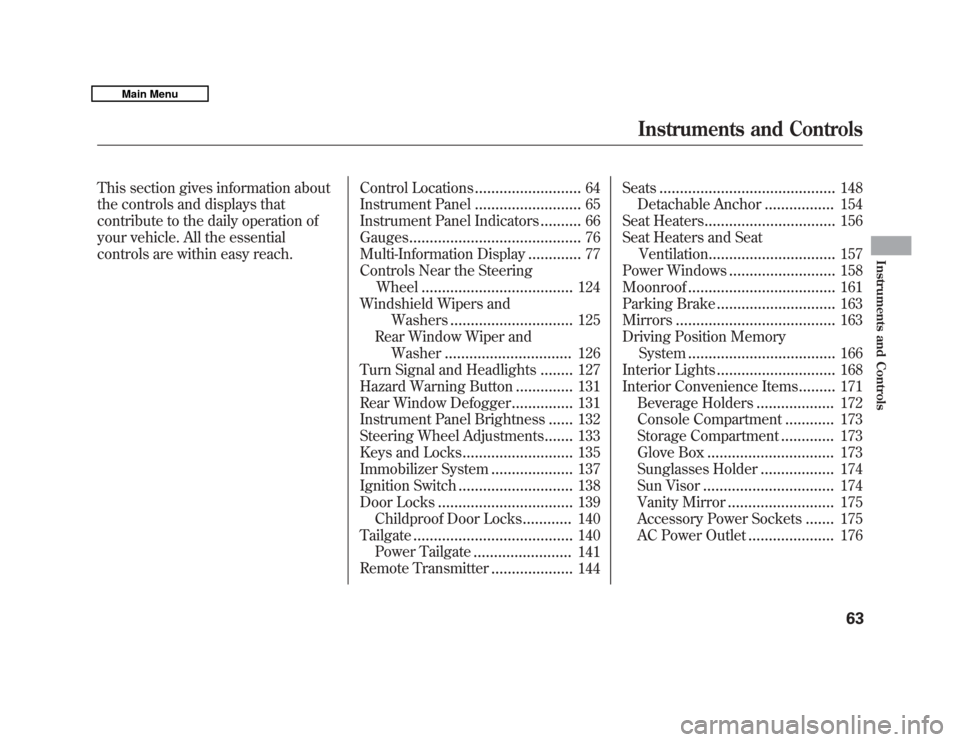
This section gives information about
the controls and displays that
contribute to the daily operation of
your vehicle. All the essential
controls are within easy reach.Control Locations
..........................
64
Instrument Panel
..........................
65
Instrument Panel Indicators
..........
66
Gauges
..........................................
76
Multi-Information Display
.............
77
Controls Near the Steering
Wheel
.....................................
124
Windshield Wipers and Washers
..............................
125
Rear Window Wiper and Washer
...............................
126
Turn Signal and Headlights
........
127
Hazard Warning Button
..............
131
Rear Window Defogger
...............
131
Instrument Panel Brightness
......
132
Steering Wheel Adjustments
.......
133
Keys and Locks
...........................
135
Immobilizer System
....................
137
Ignition Switch
............................
138
Door Locks
.................................
139
Childproof Door Locks
............
140
Tailgate
.......................................
140
Power Tailgate
........................
141
Remote Transmitter
....................
144 Seats
...........................................
148
Detachable Anchor
.................
154
Seat Heaters
................................
156
Seat Heaters and Seat
Ventilation
...............................
157
Power Windows
..........................
158
Moonroof
....................................
161
Parking Brake
.............................
163
Mirrors
.......................................
163
Driving Position Memory System
....................................
166
Interior Lights
.............................
168
Interior Convenience Items
.........
171
Beverage Holders
...................
172
Console Compartment
............
173
Storage Compartment
.............
173
Glove Box
...............................
173
Sunglasses Holder
..................
174
Sun Visor
................................
174
Vanity Mirror
..........................
175
Accessory Power Sockets
.......
175
AC Power Outlet
.....................
176
Instruments and Controls
63
Instruments and Controls
10/06/29 11:59:04 11 ACURA MDX MMC North America Owner's M 50 31STX640 enu
Page 69 of 609
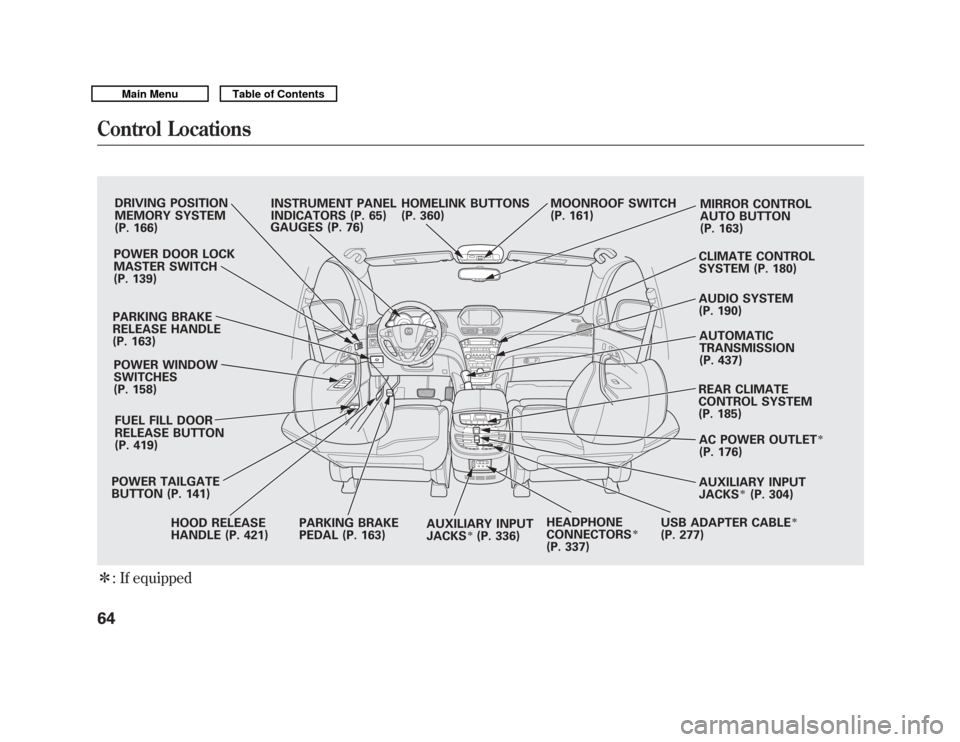
ꭧ: If equipped
DRIVING POSITION
MEMORY SYSTEM
(P. 166)
POWER DOOR LOCK
MASTER SWITCH
(P. 139)
PARKING BRAKE
RELEASE HANDLE
(P. 163) POWER WINDOW
SWITCHES
(P. 158)
FUEL FILL DOOR
RELEASE BUTTON
(P. 419)
POWER TAILGATE
BUTTON (P. 141) HOOD RELEASE
HANDLE (P. 421) PARKING BRAKE
PEDAL (P. 163)
AUXILIARY INPUT
JACKS
ꭧ(P. 336)HEADPHONE
CONNECTORS
ꭧ
(P. 337) REAR CLIMATE
CONTROL SYSTEM
(P. 185)
AUTOMATIC
TRANSMISSION
(P. 437)
AUDIO SYSTEM
(P. 190) CLIMATE CONTROL
SYSTEM (P. 180) MIRROR CONTROL
AUTO BUTTON
(P. 163)
MOONROOF SWITCH
(P. 161)
HOMELINK BUTTONS
(P. 360)
INSTRUMENT PANEL
INDICATORS (P. 65)
GAUGES (P. 76)
AC POWER OUTLET
ꭧ
(P. 176)
AUXILIARY INPUT
JACKS
ꭧ(P. 304)
USB ADAPTER CABLE
ꭧ
(P. 277)
Control Locations6410/06/29 11:59:04 11 ACURA MDX MMC North America Owner's M 50 31STX640 enu
Page 70 of 609
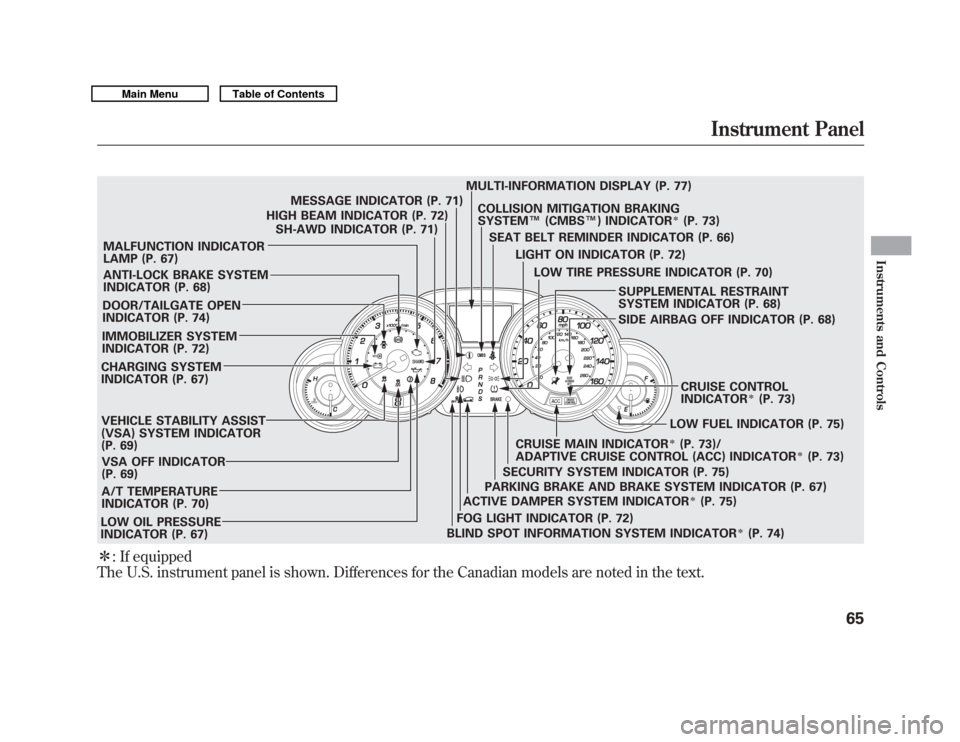
ꭧ: If equipped
The U.S. instrument panel is shown. Differences for the Canadian models are noted in the text.
MESSAGE INDICATOR (P. 71)
HIGH BEAM INDICATOR (P. 72) SH-AWD INDICATOR (P. 71)
ANTI-LOCK BRAKE SYSTEM
INDICATOR (P. 68)
FOG LIGHT INDICATOR (P. 72)
DOOR/TAILGATE OPEN
INDICATOR (P. 74)
IMMOBILIZER SYSTEM
INDICATOR (P. 72)
CHARGING SYSTEM
INDICATOR (P. 67)
VEHICLE STABILITY ASSIST
(VSA) SYSTEM INDICATOR
(P. 69) SECURITY SYSTEM INDICATOR (P. 75)
ACTIVE DAMPER SYSTEM INDICATOR
ꭧ(P. 75)
PARKING BRAKE AND BRAKE SYSTEM INDICATOR (P. 67) LOW FUEL INDICATOR (P. 75)
SEAT BELT REMINDER INDICATOR (P. 66)
COLLISION MITIGATION BRAKING
SYSTEM
™(CMBS ™) INDICATOR
ꭧ(P. 73)
SUPPLEMENTAL RESTRAINT
SYSTEM INDICATOR (P. 68)
CRUISE MAIN INDICATOR
ꭧ(P. 73)/
ADAPTIVE CRUISE CONTROL (ACC) INDICATOR
ꭧ(P. 73)
MALFUNCTION INDICATOR
LAMP (P. 67)
VSA OFF INDICATOR
(P. 69)
A/T TEMPERATURE
INDICATOR (P. 70) BLIND SPOT INFORMATION SYSTEM INDICATOR
ꭧ(P. 74)
CRUISE CONTROL
INDICATORꭧ(P. 73)
MULTI-INFORMATION DISPLAY (P. 77)
LOW TIRE PRESSURE INDICATOR (P. 70)
LOW OIL PRESSURE
INDICATOR (P. 67) LIGHT ON INDICATOR (P. 72)
SIDE AIRBAG OFF INDICATOR (P. 68)
Instrument Panel
65
Instruments and Controls
10/06/29 11:59:04 11 ACURA MDX MMC North America Owner's M 50 31STX640 enu